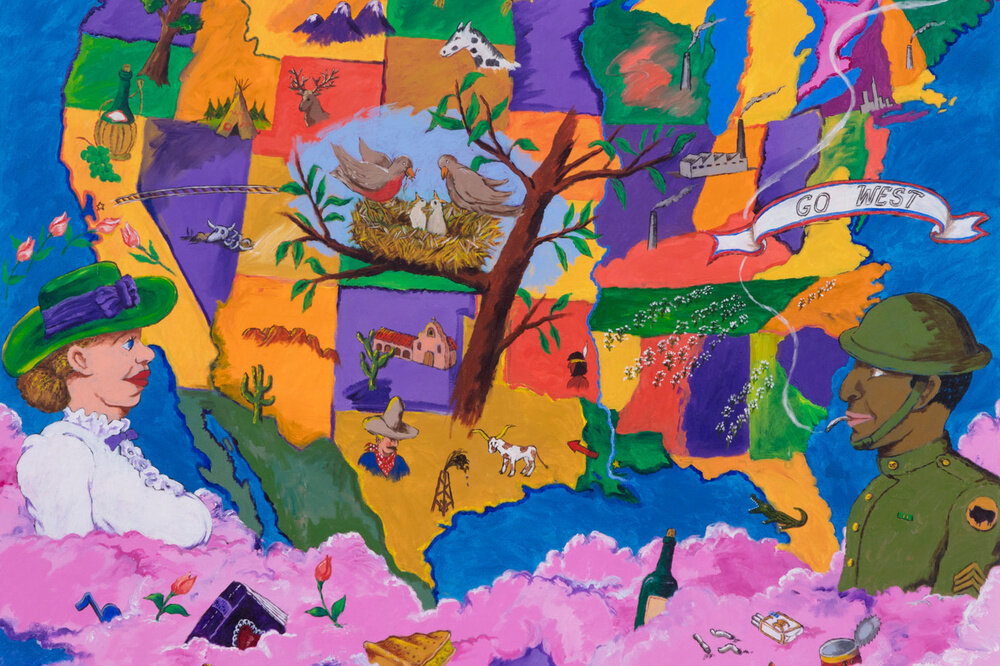Chicago Tribune: Review: ‘Art and Race Matters: The Career of Robert Colescott’ Is Now at Chicago Cultural Center, a Rogue Artist Perfect for These Time
January 26, 2022
Lori Waxman
Read hereIs there an artist better suited than Robert Colescott to test the limits of our current moment, when calls for social justice have led to demands for cultural censorship and art institutions have become loathe to offend? The man who depicted a busty Aunt Jemima flipping pancakes for some white cowboy, a nearly naked beauty queen against a backdrop of her forced sexual escapades, and a spoof of Van Gogh’s “Potato Eaters” featuring grinning minstrel figures might be exactly what we need: an artist seemingly determined to upset just about everyone, coming from a place of unstinting and complex political awareness, and who painted any which way he needed to, art world trends be damned.
“Art and Race Matters: The Career of Robert Colescott,” on view at the Chicago Cultural Center through the end of May, is a traveling retrospective of the late artist who died in 2009. He was born in 1925 to parents who left New Orleans for Oakland, California, and who from then on passed as white, as Colescott himself did until he was in his 40s. After a stint in the Army at the end of World War II, he studied in Paris with Fernand Léger, learning to eschew abstraction in favor of the approachableness of figuration. Back in the U.S. he earned advanced art degrees at universities in California, then taught in Seattle and Portland before taking up a pivotal residency in Cairo in the mid-’60s, where he painted some of his stranger, more startling pictures, like “We Await Thee,” in which figures disobey the laws of gravity and broad patches of color disregard the rules of space. (It’s huge, like most of the work on view.) Forced to leave Egypt because of the Six Day War, Colescott returned to the U.S. in the midst of its own revolutions, settling in the Bay Area, with its countercultural contemporary art scene, determined to self-identity as a Black man in both his life and work.
Colescott represented the U.S. at the 1997 Venice Biennale, the first African American ever to do so, but he is one of very few artists to have achieved that honor and not become a household name, even in artsy households. “Why not” is a question with many answers, not least among them the kind of institutional racism that has long seen artists of color not get their due, even when it seems they are. The opportunity afforded by this exhibition, however, is to look long and hard at Colescott’s artworks, from the very beginning to the very end of his career, and to observe both their strength and limitation. Simply put, Colescott painted formidably well, but he also painted pictures that can be incredibly uncomfortable to look at. He dealt head-on with racism and sexism, more often than not through the lens of crude, comedic exaggeration and popular imagery. Imagine the cutting, raunchy politics of Richard Pryor run through the visual filter of Pop Art and you’ll be halfway there.
The art world has never had much of a sense of humor, and its viewers (and curators and collectors) generally prefer to assume a stance of superiority with respect to the failings of the world. This can be hard to do when faced with a painting like Colescott’s “Rejected Idea for a Drostes Chocolate Advertisement” — an enormous, cheerfully colored picture from 1974, represented in the exhibition by a pencil study — which shows a pair of old-fashioned ice skaters on a Dutch canal, the girl black-faced beneath her peaked Dutch bonnet, the boy with his penis sticking out of his trousers, erect. Colonialism, exhibitionism, interracial sex, it’s all here, wrapped up in the maximally inappropriate form of an illustration of childhood innocence. Laugh or don’t — either way you’re implicated, and so is the artist. Ditto with Colescott’s takes on Susannah doing a striptease for the voyeuristic Elders, Huck Finn propositioning Tom Sawyer, George Washington Carver crossing the Delaware, a Roy Lichtenstein interior newly peopled by a Black woman in a bikini, and, my favorite, Willem de Kooning’s famed “Woman I” with a smiling mammy head. (The exhibition debuted at the Contemporary Arts Center in Cincinnati; this last, sadly, is not on view in Chicago.) The more sacrosanct, the sharper the satire.
Colescott’s late work is not so funny. But what it lacks in farce, it gains in thrilling weirdness, compositional complexity, painterly masterfulness, and a subject matter that expanded to include Middle Eastern politics and Native American rights. Canvases such as “School Days,” with its dizzying mashup of fragmented scenes, fantastical realism and multihued characters, nearly bursts from the confines of its frame. There is also a newfound tenderness on display in pictures like “Beauty is Only Skin Deep,” evident in the gentle caress of a brown head painted with no exaggeration; a pastel patchwork map of Africa that doubles as a percipient face seen in profile; the concerned visages that emerge out of pink clouds. A fondness for magenta, detectable in the early 80s in the lurid shirt of a self-portrait, is finally allowed to take over, becoming the color for highlighting black hair and skin, the checkers of kaffiyehs, the desert landscape and, ultimately, everything. In the final and most gorgeous work on display, a 12-foot-wide diptych painted in 2002 when Colescott was suffering from Parkinson’s, raw canvas gives way to magenta fields graffitied with bits of figuration and small eruptions of contrasting color, for an effect as close to sheer beauty as any.
